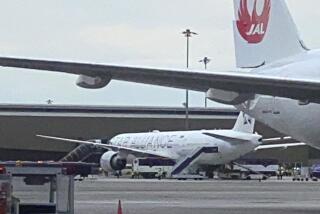Belting Them Down When Up in the Air
- Share via
Ah. Five minutes of peace. The kids had fallen asleep, exhausted from too much vacation. The flight attendant poured me a cup of coffee. I’d just gotten into my new mystery novel when we hit bumpy air.
Before the pilot could offer his customary apologies, hot coffee splattered all over my book and the children woke with a start. But at least they were safely buckled into their seats.
“We’re not going to crash, are we?” asked 10-year-old Reggie nervously, who has heard a little too much about air disasters.
Luckily, the turbulence didn’t last long and we were fine, except for a favorite purple marker, gone forever, and what would have been an excellent opportunity to read a book.
But not everyone is so fortunate. The Federal Aviation Administration reports that 58 passengers not wearing their seat belts are injured each year by turbulence while flying in the United States.
Last December, in a widely publicized case, 16 passengers on an American Airlines jet--including a 7-month-old infant--were hurt when their flight ran into clear-air turbulence over Colorado.
FAA officials explain that turbulence often occurs unexpectedly, caused by air movement related to storms, cold and warm fronts or other atmospheric conditions.
That’s why it’s essential to remain buckled throughout a flight, just as you would in a car.
“A plane could drop a couple of thousand feet,” says Jane Goodman, spokeswoman for the 40,000-member Assn. of Flight Attendants. “And when you hit a bump, the baby is going to go flying.”
Even the most vigilant parent would be hard pressed to hang on to a baby in her lap or a toddler who has made a game of unbuckling his seat belt each time it’s buckled.
“The point is the injuries caused by turbulence are completely preventable,” says FAA spokesman Alison Duquette. (For more information on turbulence, call the FAA’s Consumer Hotline at [800] FAA-SURE.)
Frankly, it’s easier in a car. There are no strangers to cast disapproving looks your way for perhaps taking more space than you’ve paid for if your baby is buckled into a vacant seat. And the kids won’t argue about staying buckled. They know that safety seats and seat belts aren’t optional. It’s the law and one that has proved a lifesaver.
Even though government and airline officials agree that approved child-safety restraints are the best way to restrain small children and babies on airplanes, they don’t require them.
The FAA’s response has been to launch a public awareness campaign urging parents to use approved child-safety seats for children under 40 pounds. But laws do not prevent parents from flying without them.
Airlines recommend that children use safety seats but provide a strong incentive to do just the opposite: free air fare, though no guaranteed seat, for children under 2 years old. Thus, on full or overbooked flights, infants and toddlers end up in their parents’ laps unless their parents paid for a seat in advance.
Few parents recognize the value of safety seats in the air. Five babies who died in plane accidents or incidents in the past 18 years could have survived had they been restrained, the FAA reported in a recent study.
The FAA’s official line is that mandating the use of safety seats would up the cost of air travel for families and force more of them to travel by car, which then could result in a projected 82 additional traffic fatalities over the next decade. Flight attendants who lobbied hard for a new law counter that babies are the only item on board planes--including coffee cups--that aren’t tied down.
But even public awareness of air safety hasn’t helped the cause. “We haven’t seen a major increase in usage,” says the Flight Attendants’ spokeswoman Goodman.
What can parents do? Write or e-mail your congressman to express your concern. Send another letter to the president of your favorite airline explaining why parents should be encouraged to use child-safety seats.
Most important, press every parent you know to lug that safety seat to the gate the next time they fly with their baby or toddler. If they haven’t bought a ticket for their child, the airline will do its best to give them an empty seat if it’s available.
It’s worth the hassle--one bumpy patch is all it takes to ruin your trip, or worse.
Taking the Kids appears the first and third week of every month.
More to Read
Sign up for The Wild
We’ll help you find the best places to hike, bike and run, as well as the perfect silent spots for meditation and yoga.
You may occasionally receive promotional content from the Los Angeles Times.






